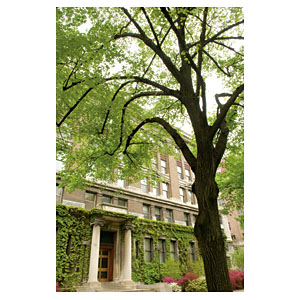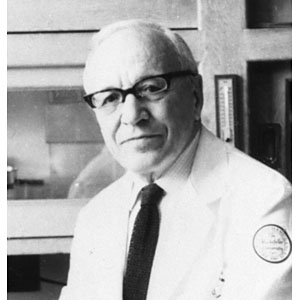|
The Rockefeller University and Dr. Alfred Mirsky
Biography, The Rockefeller University and Dr. Alfred Mirsky
 The Rockefeller University is one of the world’s foremost biomedical research institutes and is dedicated to conducting innovative, high-quality research to
improve the understanding of life for the benefit of humanity. Founded in 1901, The Rockefeller Institute for Medical Research was the country’s first institution devoted exclusively to biomedical research. In the 1950s, the institute expanded its mission to include graduate education and began training new generations of scientists to become research leaders around the world. In 1965, it was renamed The Rockefeller University.
Rockefeller’s unique approach to science has led to some of the world’s most revolutionary contributions to biology and medicine. During Rockefeller’s
history, 23 of its scientists have won Nobel Prizes, 21 have won Albert Lasker Medical Research Awards, and 13 have been awarded the National Medal of Science,
the highest science award given by the United States.
Dr. Alfred Mirsky (1900-1974) was a world-renowned pioneer in the fields of the chemistry of proteins and chromosomes. When Dr. Mirsky died, Rockefeller University President Dr.
Frederick Seitz noted that he had been associated with Rockefeller since 1927 and that he was “one of the pioneers in unlocking the secrets of the cell nucleus.”
In addition to his fundamental contributions in protein chemistry, Dr. Mirsky and his colleagues made the crucial demonstration that every cell in the body has the same amount of
DNA as every other cell except for the sperm and egg cells, which have half the amount. When combined in the fertilized egg, they produce the normal complement of DNA, the basic genetic
material often referred to as the “blueprint of life.”
Archaeology and numismatics were also life-long interests for Dr. Mirsky. As noted in Mirsky’s obituary in the Year Book of the American Philosophical Society 1976: 100-103, “He was well
known to dealers throughout the world for his ‘fine eye’ and his expertise. This was developed during years of poring over books, dealers’ catalogs and inventories, as well as visiting
archaeological sites.”
The Rockefeller University is one of the world’s foremost biomedical research institutes and is dedicated to conducting innovative, high-quality research to
improve the understanding of life for the benefit of humanity. Founded in 1901, The Rockefeller Institute for Medical Research was the country’s first institution devoted exclusively to biomedical research. In the 1950s, the institute expanded its mission to include graduate education and began training new generations of scientists to become research leaders around the world. In 1965, it was renamed The Rockefeller University.
Rockefeller’s unique approach to science has led to some of the world’s most revolutionary contributions to biology and medicine. During Rockefeller’s
history, 23 of its scientists have won Nobel Prizes, 21 have won Albert Lasker Medical Research Awards, and 13 have been awarded the National Medal of Science,
the highest science award given by the United States.
Dr. Alfred Mirsky (1900-1974) was a world-renowned pioneer in the fields of the chemistry of proteins and chromosomes. When Dr. Mirsky died, Rockefeller University President Dr.
Frederick Seitz noted that he had been associated with Rockefeller since 1927 and that he was “one of the pioneers in unlocking the secrets of the cell nucleus.”
In addition to his fundamental contributions in protein chemistry, Dr. Mirsky and his colleagues made the crucial demonstration that every cell in the body has the same amount of
DNA as every other cell except for the sperm and egg cells, which have half the amount. When combined in the fertilized egg, they produce the normal complement of DNA, the basic genetic
material often referred to as the “blueprint of life.”
Archaeology and numismatics were also life-long interests for Dr. Mirsky. As noted in Mirsky’s obituary in the Year Book of the American Philosophical Society 1976: 100-103, “He was well
known to dealers throughout the world for his ‘fine eye’ and his expertise. This was developed during years of poring over books, dealers’ catalogs and inventories, as well as visiting
archaeological sites.”
 Dr. Mirsky acquired his marvelous ancient coin collection prior to 1970 (the cataloguers were unable to identify any coins purchased after 1959). The collection, parts of which
have been on display at The Rockefeller University over the years, was bequeathed to the University as a testamentary gift. Proceeds from the sale of this collection will support the
University’s graduate program. The collection includes coins from many of the great early 20th century collections of ancient coins, including collections of J. Pierpont Morgan, Richard
Cyril Lockett, Consul Edward F. Weber, Professor S. Pozzi, and the Hermitage Museum. Dr. Mirsky also purchased his coins from the world’s great ancient coin dealers of his day including
Giuseppe De Falco (Naples), Jacques Schulman (Amsterdam), Spink & Son (London), M&M (Basil), Bank Leu (Zurich) and A.H. Baldwin and Sons (London).
It is an interesting footnote that in October, 1953, Dr. Mirsky wrote a letter recommending Vladimir Clain-Stefanelli as curator of the Smithsonian Institution’s Department of
Numismatics. Clain-Stefanelli, a survivor of several years at the Buchenwald concentration camp, had arrived in New York in 1951 and was befriended by Dr. Mirsky when he was employed by
Hesperia Arts and Stack’s Rare Coins. In 1956 Vladimir became curator of the Smithsonian’s Division of Numismatics; a year later, his wife Elvira became his assistant. Two years after Vladimir’s
death in 1982, Elvira Clain-Stefanelli became the department’s first executive director; she died in 2001.
Dr. Mirsky was born in New York City on October 17, 1900. He graduated from the Ethical Culture School and Harvard University, received his Ph.D. degree from Cambridge University,
and received an honorary M.D. degree from the University of Gothenburg in 1954. He joined the Rockefeller Institute in 1927, and held the positions of associate (1929-1940), associate member
(1940-1948) and member, before assuming the title of professor in 1954. He was a member of the National Academy of Sciences, the American Philosophical Society, Harvey Society, the Society of
Biological Chemists, Society of General Physiologists, Genetics Society, American Naturalists Society, Deutsche Akademie der Naturforscher, American Academy of Arts and Sciences, American
Chemical Society, and Phi Beta Kappa.
Dr. Mirsky acquired his marvelous ancient coin collection prior to 1970 (the cataloguers were unable to identify any coins purchased after 1959). The collection, parts of which
have been on display at The Rockefeller University over the years, was bequeathed to the University as a testamentary gift. Proceeds from the sale of this collection will support the
University’s graduate program. The collection includes coins from many of the great early 20th century collections of ancient coins, including collections of J. Pierpont Morgan, Richard
Cyril Lockett, Consul Edward F. Weber, Professor S. Pozzi, and the Hermitage Museum. Dr. Mirsky also purchased his coins from the world’s great ancient coin dealers of his day including
Giuseppe De Falco (Naples), Jacques Schulman (Amsterdam), Spink & Son (London), M&M (Basil), Bank Leu (Zurich) and A.H. Baldwin and Sons (London).
It is an interesting footnote that in October, 1953, Dr. Mirsky wrote a letter recommending Vladimir Clain-Stefanelli as curator of the Smithsonian Institution’s Department of
Numismatics. Clain-Stefanelli, a survivor of several years at the Buchenwald concentration camp, had arrived in New York in 1951 and was befriended by Dr. Mirsky when he was employed by
Hesperia Arts and Stack’s Rare Coins. In 1956 Vladimir became curator of the Smithsonian’s Division of Numismatics; a year later, his wife Elvira became his assistant. Two years after Vladimir’s
death in 1982, Elvira Clain-Stefanelli became the department’s first executive director; she died in 2001.
Dr. Mirsky was born in New York City on October 17, 1900. He graduated from the Ethical Culture School and Harvard University, received his Ph.D. degree from Cambridge University,
and received an honorary M.D. degree from the University of Gothenburg in 1954. He joined the Rockefeller Institute in 1927, and held the positions of associate (1929-1940), associate member
(1940-1948) and member, before assuming the title of professor in 1954. He was a member of the National Academy of Sciences, the American Philosophical Society, Harvey Society, the Society of
Biological Chemists, Society of General Physiologists, Genetics Society, American Naturalists Society, Deutsche Akademie der Naturforscher, American Academy of Arts and Sciences, American
Chemical Society, and Phi Beta Kappa.
|

